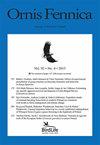Diet and grit characteristics in young Eurasian Bullfinches (Pyrrhula pyrrhula) inhabiting Iberian hedgerows
IF 1.2
4区 生物学
Q2 ORNITHOLOGY
引用次数: 0
Abstract
For the first time, the diet of young Iberian Bullfinches (Pyrrhula pyrrhula iberiae) is studied, specifically in a hedgerow habitat in northwestern Spain, through stomach (younger nestlings up to 8 d of age, which died without researcher intervention) and faecal sac (older nestlings) analysis, and secondarily direct observation (nestlings and dependent juveniles). Also, for the first time, grit use by bullfinch nestlings is described in some detail. Bullfinches fed their young with a mixture of seeds and invertebrates, with greater quantitative importance of the former. The identity of the seeds varied considerably between spring and summer, and animal fraction gradually decreased from May to July for older nestlings, in both cases presumably because of the seasonal changes in food availability. Caterpillars and spiders were the most important arthropod prey in the diet. Apparently, the young were not fed non-arthropod invertebrates. The relative importance of invertebrates, which are very rich in proteins, was greater for younger nestlings than for older ones. Difficult to digest hard-bodied prey, such as beetles, were not present in the stomachs of the youngest nestlings. The frequency of occurrence and amount of grit in stomachs increased with nestling age, along with the need to grind food. There were no remarkable differences in number of units, size, or number of colour types of gastroliths between months. The high floristic diversity in the study area, which has great overall conservation value, provides a wide range of resources for bullfinches, including plenty of food for their young.居住在伊比利亚树篱中的欧亚牛雀(Pyrhula pyrhula)的饮食和砂砾特征
首次通过胃(8日龄以下的幼鸟,在没有研究人员干预的情况下死亡)和粪囊(较大的幼鸟)分析,以及第二次直接观察(幼鸟和依赖幼鸟),研究了幼年伊比利亚牛雀(Pyrhula pyrhula iberiae)的饮食,特别是在西班牙西北部的树篱栖息地。此外,首次详细描述了牛蛙雏鸟使用砂砾的情况。金翅雀用种子和无脊椎动物的混合物喂养幼鸟,前者在数量上更重要。春季和夏季之间,种子的特性差异很大,从5月到7月,年龄较大的雏鸟的动物比例逐渐下降,这可能是因为食物供应的季节性变化。毛虫和蜘蛛是食物中最重要的节肢动物猎物。显然,这些幼崽没有被喂食非节肢动物无脊椎动物。无脊椎动物富含蛋白质,其相对重要性对年轻的雏鸟来说比年长的雏鸟更大。难以消化的坚硬猎物,如甲虫,不存在于最年轻的雏鸟的胃里。胃中砂砾的出现频率和数量随着年龄的增长而增加,同时也需要研磨食物。不同月份胃石的单位数量、大小或颜色类型的数量没有显著差异。研究区的植物区系多样性很高,具有很大的整体保护价值,为斗牛犬提供了广泛的资源,包括为它们的幼崽提供了充足的食物。
本文章由计算机程序翻译,如有差异,请以英文原文为准。
求助全文
约1分钟内获得全文
求助全文
来源期刊

Ornis Fennica
生物-鸟类学
CiteScore
2.00
自引率
0.00%
发文量
14
审稿时长
>12 weeks
期刊介绍:
Ornis Fennica is a peer-reviewed international ornithological journal published by BirdLife Finland. Ornis Fennica publishes analytical and experimental papers on the ecology, behaviour and biogeography of birds. Ornis Fennica prefers studies concerning Fennoscandian species, but other novel contributions of general interest are most welcome as well.
Ornis Fennica is an open-access journal without page charges for publication. All published articles (from 1924 onwards) are freely available from the journal website. First decisions are usually made within three months of submission.
 求助内容:
求助内容: 应助结果提醒方式:
应助结果提醒方式:


